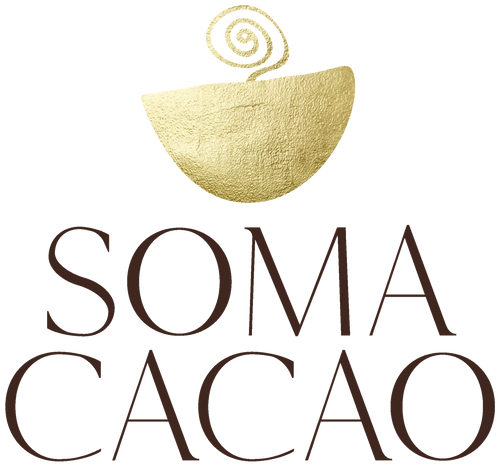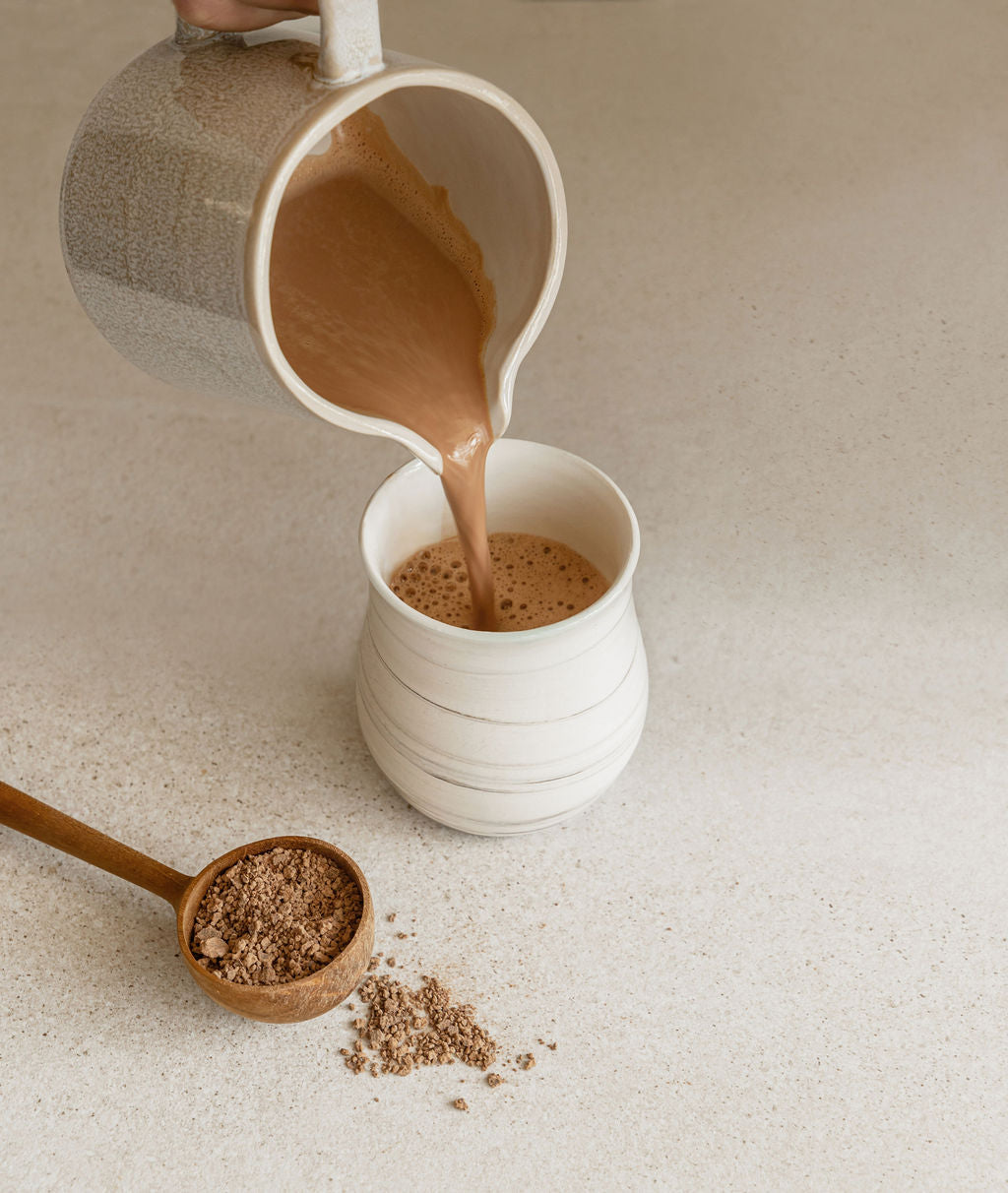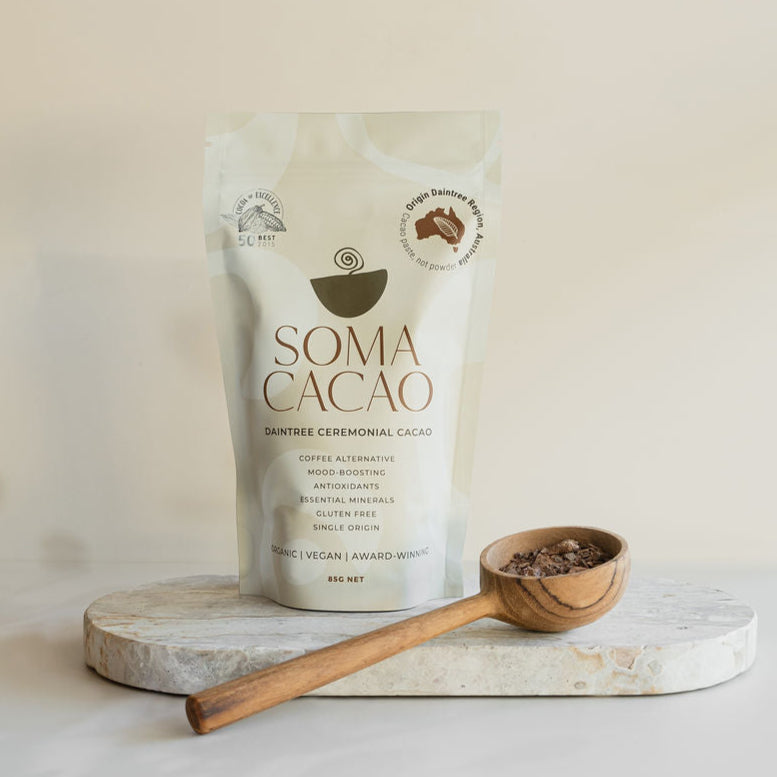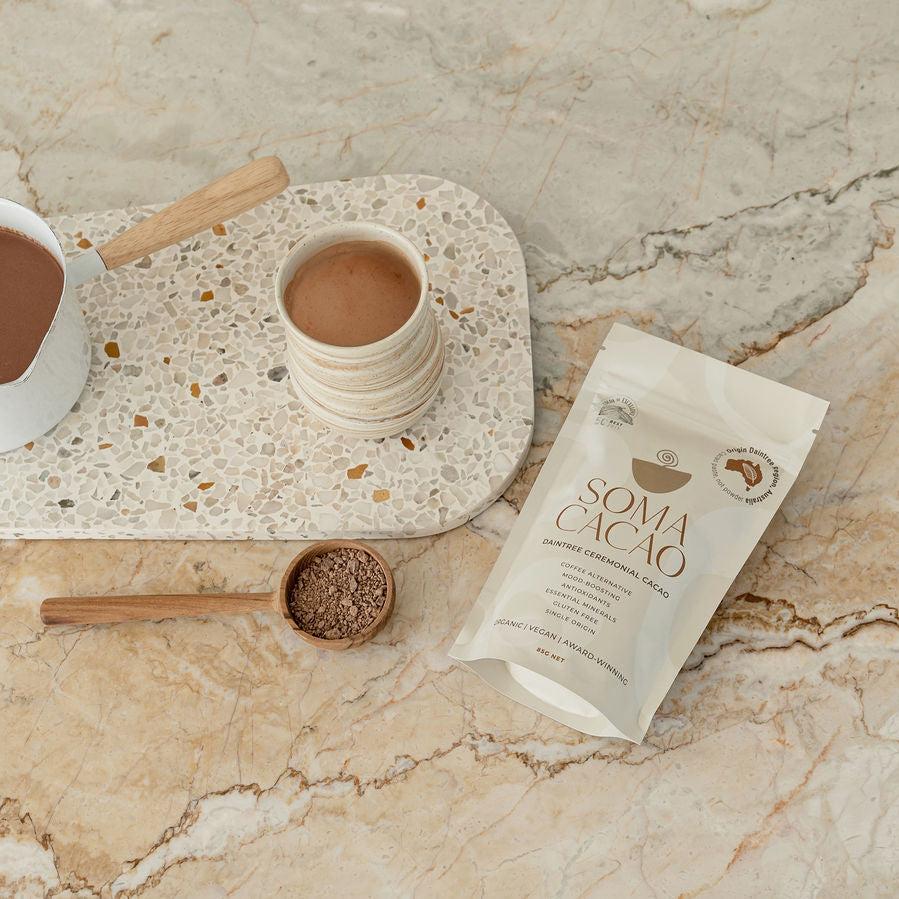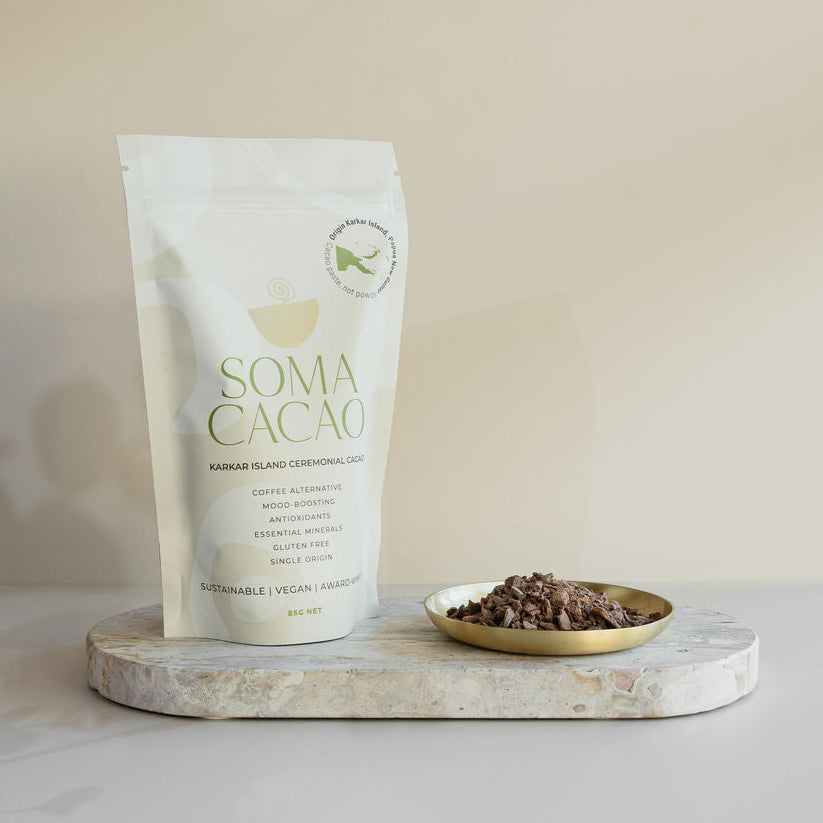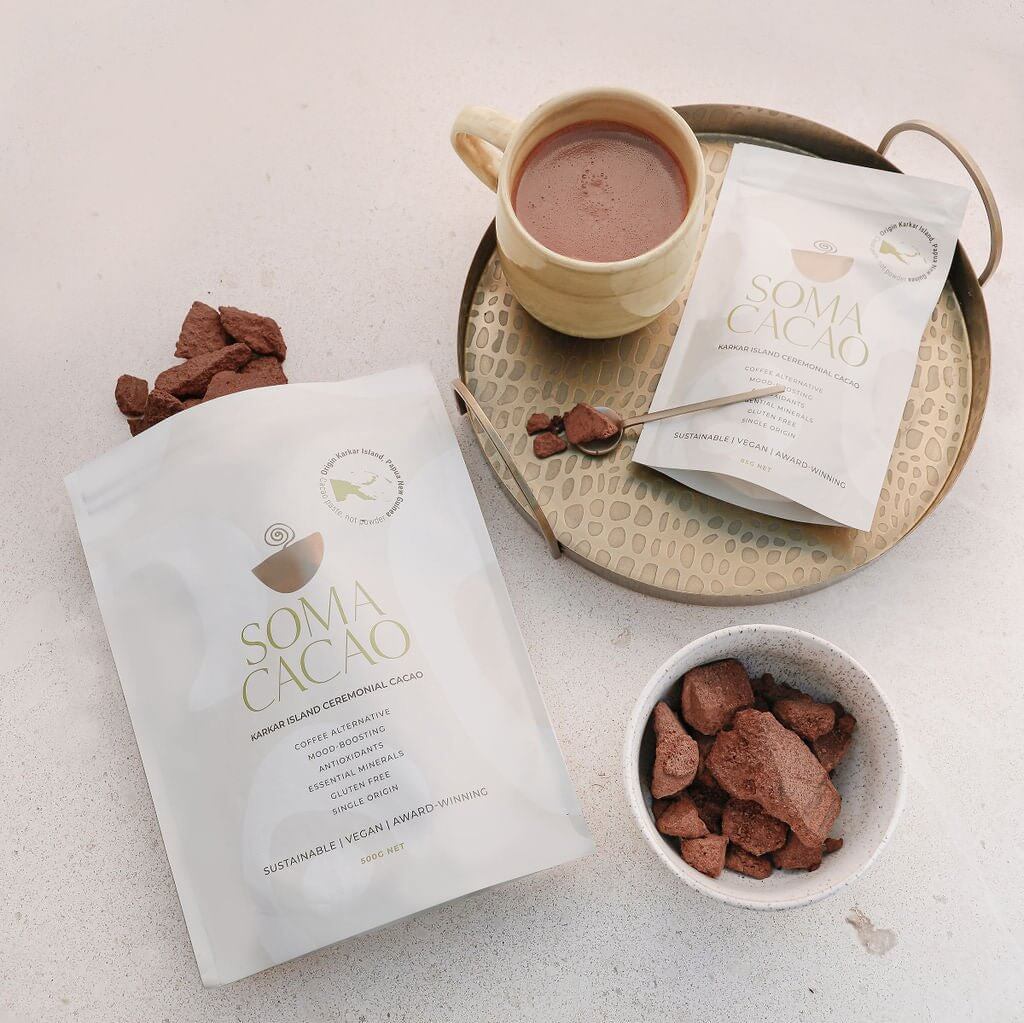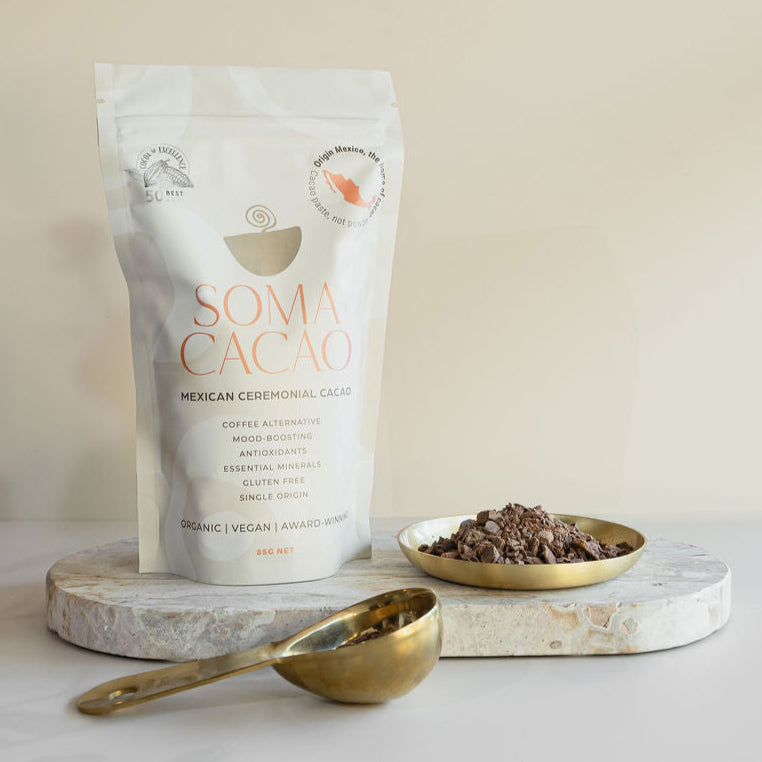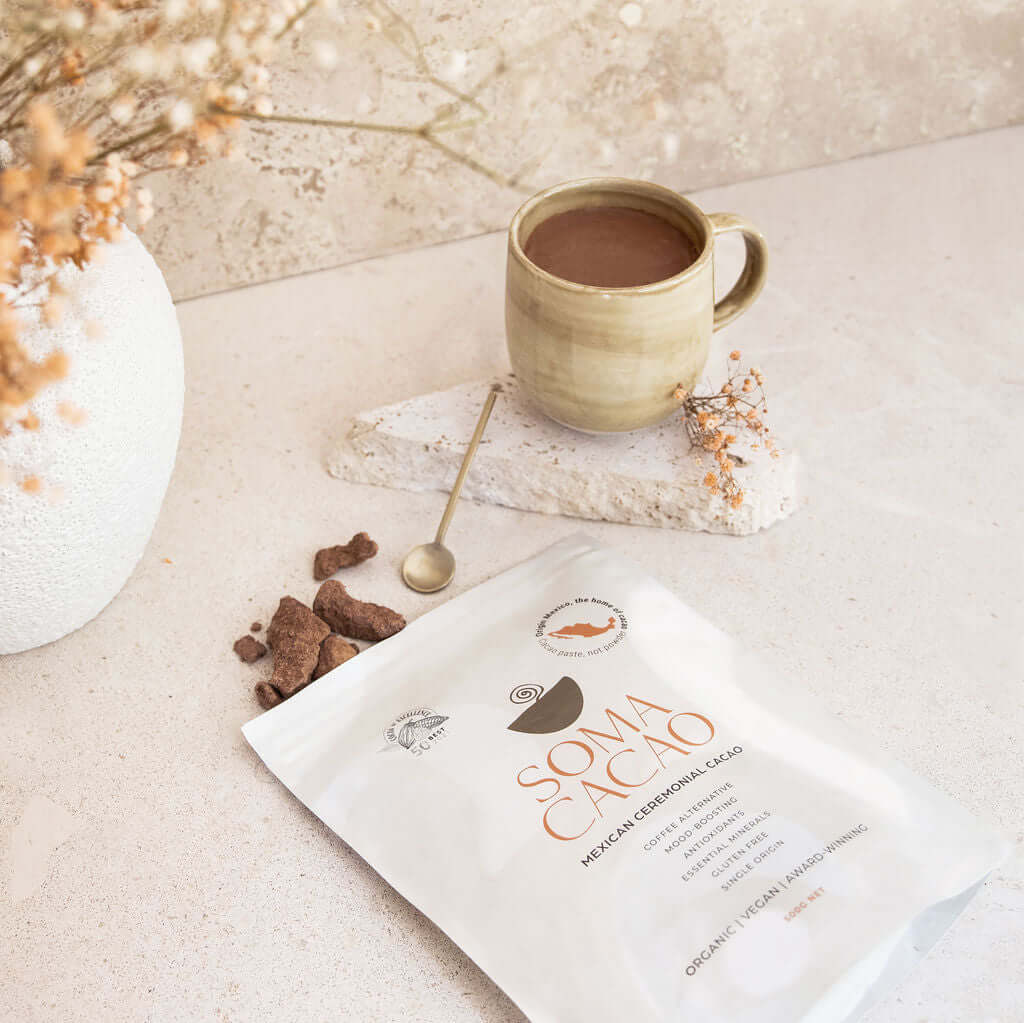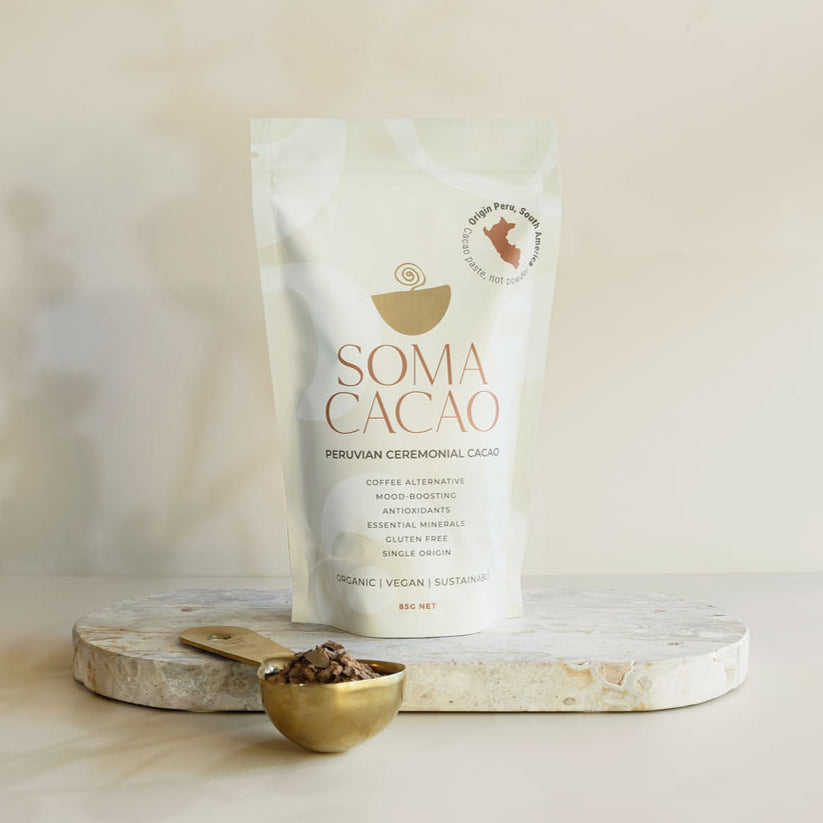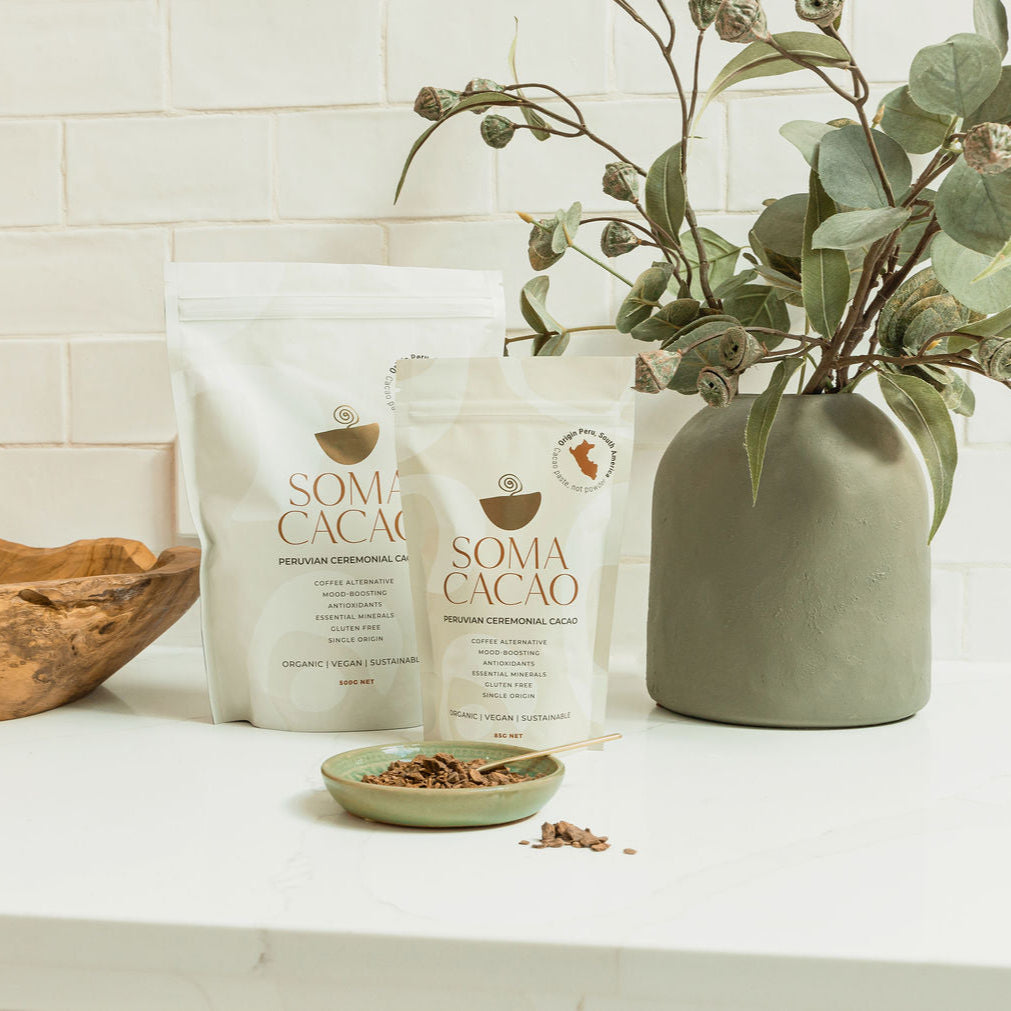ABOUT CACAO.
-
There is only one ingredient in our cacao: cacao.
It is 100% pure whole-bean cacao paste, which is solid at room temperature. We add nothing, we take nothing away.
We’ve shaved up our solidified cacao paste so that you can easily scoop out your preferred dose to prepare your morning cup (or evening nightcap!), or alternatively to sprinkle on cereal, use in smoothies, or make delicious vegan treats. See our recipes for inspiration!
-
Cacao powder is to cacao what instant coffee is to an espresso - a poor imitation.
To make our cacao paste the fruits of the theobroma cacao tree are hand-picked, fermented, sun-dried, roasted lightly and ground up into a paste. The paste sets, we chop it. Then we share it with you.
Cacao powder (or cocoa powder) has undergone intensive processing to extract cacao butter from the paste. This leaves the cacao chalkier and more insipid, and also reduces the fat content, which is vital for the transmission of the neuro-active substances. Studies have proven the widely used method to produce cocoa powder (dutch-processing) significantly decreases the levels of compounds with positive physiological effects.
-
The use of the word “cacao” vs “cocoa” is inconsistent. The general rule of thumb is that “cacao” should be used when referring to the pods, beans and ground contents of the beans (i.e. the cacao nibs or whole bean cacao paste), and “cocoa” for the powder left after pressing the fat out of the ground beans. Increasingly “cacao” is also used to describe powder that has been processed raw or at a very low temperature. Raw cacao is a healthy supplement, but it does not contain the same psychoactive compounds as whole bean cacao paste, nor does it have the same decadent flavour or texture. Don’t take it from us though! You’ll be able to taste, and feel the difference for yourself.
-
As an energy source cacao feels more gentle, long-lasting and smooth, while coffee is intense, fast-acting and short-lived. This is because caffeine is a nervous system stimulant, and it produces cortisol, the stress hormone, which can lead to the jitters and anxiety. By contrast, cacao's active ingredient, theobromine, reduces cortisol. This helps us to relax. Cacao also stimulates the cardiovascular system, and opens our blood vessels. This helps blood flow more freely, sends more oxygen through the body, and lowers our blood pressure. We’ve elaborated on this in a recent blog post..
-
Soma Cacao contains a modest amount of caffeine compared to coffee. Depending on the origin, a serving of Soma Cacao's ceremonial cacao has between 17 mg and 47.5 mg of caffeine—significantly less than the 120–180 mg typically found in a classic flat white, slightly less than the 60-80 mg found in matcha, and about the same as a cup of green tea.
This lower caffeine content, combined with higher theobromine levels, offers a smoother, more sustained energy boost. Read more. -
Our Peruvian, Solomon Islands, and Daintree cacaos are certified organic.
However, while our Mexican and Karkar Island cacao are also grown without artificial pesticides and are produced using sustainable, traditional practices— they lack formal organic certification. In many of these countries, the certification process is highly bureaucratic, involving extensive paperwork and significant expense.
This doesn’t compromise the quality or integrity of the cacao; it simply reflects the challenges and costs associated with obtaining certification in certain regions. We work closely with our farmers to ensure that every batch of cacao meets our high standards for purity and sustainability. -
Please rest assured that all of our cacao is heavy metal safe in accordance with EU, Australian, and US regulations. You can find our latest test results in our recent article: Heavy Metals, Chocolate & Cacao: Weighing in on the Media Frenzy.
It’s important to note that no food can be completely “heavy metal free” due to their natural occurrence in the environment.
Claims promising 100% heavy metal–free cacao are therefore misleading.
Instead, we focus on strict sourcing and rigorous testing protocols to ensure our product not only meets but exceeds safety standards. This way, you can enjoy the benefits and rich taste of our cacao with complete peace of mind. -
1. Measure 25-30 grams (2 tablespoons) for a creative boost, or 45 grams (3 tablespoons) for a ceremonial dose.
2. Place in a heat-proof blender with:
- 100 ml hot water (not boiling);
- 50 ml milk (we like oat milk the best)
- sweetener to taste (we use 1-2 teaspoons of coconut sugar or honey)
- optional extras (we like adding cinnamon and sea salt. You can also try ginger, cardamom, vanilla or cayenne pepper).
3. Blend and pour into your favourite mug. Aaaaand enjoy!
NOTE: If you don’t have a heat-proof blender, a hand-held blender (or bar-mix) works very well too.
If you have access to neither, you can simply place the cacao in a mug, add a little hot water, and stir through to melt the cacao into a paste. Gradually add more water and the other ingredients, stirring continuously.
For more information on preparing your cacao, visit our preparation page.
-
The primary uses of cacao include:
- for daily drinking as a jitter-free, mood-enhancing, anxiety-reducing, nutrient-rich alternative to coffee;
- for a creative boost to accompany dance, yoga, art, music or writing; and
- as a tool for self-exploration.
Cacao can also be used in baking, smoothies, or making delicious raw treats.
-
Unlike other plant medicines (peyote, psilocybin mushrooms, ayahuasca, etc) cacao has no hallucinogenic effects. A daily dose of cacao will provide mild stimulation similar to a cup of coffee, but more soothing and with none of the anxiety or agitation associated with coffee. Many of our customers report experiencing a profound sense of calmness as its primary effect.
As you increase your intake the psychological effects may increase. For some this will bring a sense of tenderness or vulnerability, for others joy or euphoria. It will vary from person to person, and from day to day. We invite you to experiment for yourself.
-
You may notice a slight discolouration of your cacao, or a whitish coating. This means its the real-deal: un-tempered, whole bean cacao paste. The coating is called the ‘chocolate bloom’, caused by changes in the fat crystals of cacao. Cacao that has ‘bloomed’ is still completely safe to consume. As soon as you melt down the cacao in preparation for consumption, the discolouration will disappear.
-
Stored correctly, your Soma Cacao should last 2 years. The key is to ensure it’s stored in a cool, dry, place.
-
No. Our cacao has been processed the way in which cacao has been processed for millennia: by fermenting, sun-drying, stone-grounding and roasting it. Ancient civilisations roasted cacao on the fire, almost to the point of burning the beans. Roasting cacao brings out the flavour, and reduces the bitterness.
-
There is a very small chance your cacao will melt on its way to you, and arrive as a solid mass instead of fine shavings. Rest assured that this cacao is still perfectly okay - you just need to solidify it at room temperature (or in the fridge if it’s hot) and chop it up again. We receive our cacao in blocks, and only shave it to make your experience more convenient.
-
We (Rose and Alistair) spent several years using Guatemalan and Mexican cacao that came in 500g or 1kg solid blocks. As daily cacao drinkers, and regular (pre-COVID) travellers, we found it a little frustrating to chop our cacao on the go. We would end up grating up the whole block and putting it in a sealed container so we could easily spoon out our dose each day. This is why we don’t sell it in a block. Once you place your order we chop it up for you and send it ready-to-scoop in one of our recyclable stand-up pouches.
-
It depends what your reference point is here.
If you are comparing cacao paste to cacao powder, than you would expect our cacao paste to be at least double the price, given it is MUCH harder to come by, and it contains the highly-prized cacao butter.If you are comparing to other cacao paste (ceremonial cacao) brands, then you’ll find a range of prices, and we’re about the median price. While our cacao is less expensive than some of the ceremonial cacao exported out of Central America, you might find some South American cacao paste on the Australian market that is cheaper than ours. More than likely, this will be cacao paste that is sourced from the same Organic wholesale supplier that sources cheap cacao products in bulk from Tarapoto in Peru. Because their volumes are high, their prices are low. You'll taste and feel the difference in quality.
By contrast, we have sourced award-winning cacao from small farms: the output is low, the quality is exceptional, we pay stable, premium prices that are substantially higher than commodity market and Fair Trade prices, and which are protected from market fluctuations.
CACAO AND OUR HEALTH.
-
Please visit our nutritional information page for a full breakdown of macronutrients.
-
As arguably the most nutrient-dense, chemically complex food on the planet, cacao has so many health benefits we’ve created a cacao benefits page to tell you all about it. But in short - it’s a mood-lifting, heart-opening, endurance-enhancing, appetite-suppressing superfood with an impressive array of scientifically proven benefits.
-
Generally, cacao is contraindicated with antidepressants, especially MAOIs and some SSRIs. It may result in a really bad headache, or worse, cause the development of serotonin syndrome which can have severe implications. Cacao paste contains tryptophan and MAO inhibitors that may cause a synergistic intensification when combined with antidepressants.
So it is definitely best to steer clear of cacao while on antidepressants.
-
Generally, cacao is considered totally safe during both pregnancy and breastfeeding, however a lower dose is recommended, just in case the theobromine content (the stimulant in cacao, a compound similar to caffeine, but more gentle) causes any aggravation/irritation, or nausea (we've only heard of this happening in first trimester though). The anti-depressant characteristics of cacao, i.e. the production of dopamine, serotonin, P.E.A and anandamine (the bliss molecule) could be potentially helpful for any pre- and post- natal issues, plus give a nice little energy boost too 😊.
But, we aren 't health practitioners so as with anything it is always best to double check with someone you know and trust in the realm of health.
-
Our cacao is 100% pure and contains no added allergens. However, it is processed in facilities that also handle nuts, soy, and dairy, so there may be trace amounts present. We recommend those with severe allergies consult a healthcare professional before consuming.
"CEREMONIAL" CACAO
-
Ceremonial Cacao refers to a premium, pure cacao that is ethically sourced from small family-run sustainable farms.
Ceremonial cacao is made from a single ingredient, whole cacao beans, with nothing added or removed. This is what distinguishes is from cacao powder: a product that has the highly prized cacao butter removed.
Our cacao is minimally processed to retain the highest concentration of antioxidants, bliss-inducing compounds and essential minerals.Our sourcing methods disrupt the commodity cacao supply chain, which notoriously cuts corners and is notoriously corrupt.
-
These days, a ‘cacao ceremony’ is a broad concept that includes any activity involving cacao combined with intention-setting, personal-development, creative expression, and/or spiritual exploration. It can be formal or informal, performed alone or in group, in silence or with music, and at any time of day. Refer to our recent blog post on the debates surrounding ceremonial cacao for more information.
-
What's all this talk about "ceremonial-grade cacao"?
So-called ‘ceremonial-grade cacao’ generally refers to Meso-American cacao paste that has been minimally processed, organically grown, and harvested in small-batches using traditional methods. However, we keep stumbling upon more and more products describing themselves as ‘ceremonial-grade’ that don’t meet this description. We’ve seen ‘ceremonial-grade’ cacao powder, we’ve seen the term describing cacao that has been mass-produced and exported in bulk, and with cacao grown far from its Meso-American origins - for example in Bali, Trinidad, Sri Lanka, and Tanzania. Confusing, to say the least!
There’s a heated debate surrounding the cultural appropriation of cacao which you can read about on our blog post regarding the “ceremonial-grade” cacao conundrum.
-
As explained in response to the above question, we have a number of reasons why we choose not to use the term ‘ceremonial-grade’.
However, our Mexican cacao would technically pass the ceremonial-grade checklist with flying colours: organic, criolla bean, and sustainably grown using traditional methods in small batches by a family with a long history of cacao culture. It comes from Chiapas, where some of the earliest traces of theobromine were discovered on pots and vessels, and where cacao continues to be a central part of family tradition and cultural
practice. Our Australian, Karkar Island and Solomon Islands cacao would technically not classify as ceremonial-grade because it is not grown in Central or South America. It is also not criolla bean cacao, widely considered a key factor in ceremonial-grade classifications (though according to Steve Bergin from Conservation Cacao, “classifying cacao as Criollo/Forastero/Trinitario was one of the great foundational linguistic screw-ups in the history of the New World, though rather short of Columbus calling the Arawak peoples he met Indians”).
Linguistic screw-ups aside, our other varieties of cacao consist predominantly of ‘trinitario’ beans - which tend to have a richer, rounder, smoother flavour, highly prized for chocolate, and which have been shown to have the same psychoactive properties as criolla bean cacao, though with a generally higher concentration of theobromine.
Shipping & Delivery
-
Our team tends to fulfil orders between 1-2 business days (that's excluding weekends and public holidays).
On top of that, we need to add the time it takes for Australia Post to delivery your items. We ship from Far North Queensland.
For the most up to date shipping times, best to check with the Australia Post website directly here.
Our full shipping policy is available here. -
We currently do not offer free shipping. While many large retailers often include it as a standard perk, free shipping comes with significant costs that we, as a small business, need to manage. Your support helps us keep our business sustainable and continue offering quality products.
We've written about this more extensively here.
-
At this stage we only ship to Australia and New Zealand. Our supplies are limited so we need to take care of our local customers first, but we'll be sure to let you all know if we are able to expand this at any point.
SHOP CACAO
Our 100% pure, award-winning ceremonial cacaos are crafted from a single ingredient—minimally processed cacao beans—finely shaved for easy preparation. Each cacao has a unique flavour profile, a little like fine wine.
